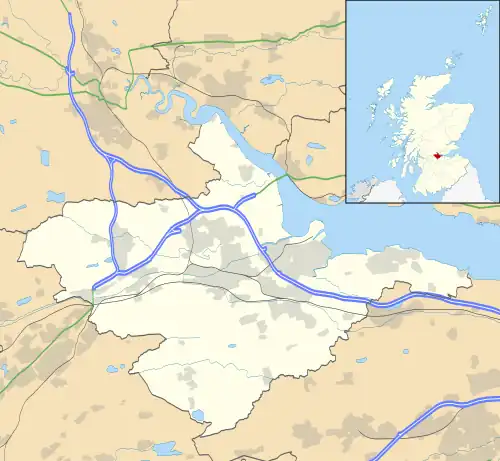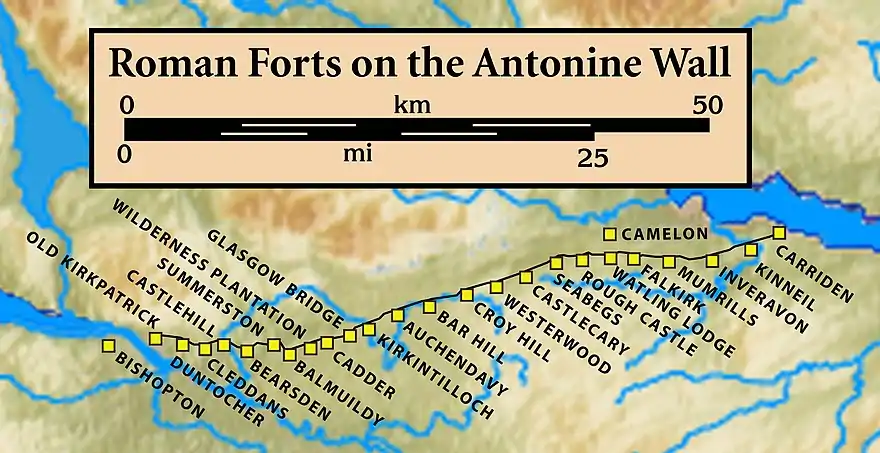Camelon
| |
|---|---|
 Camelon swing bridge over the Forth and Clyde Canal at Camelon lock. | |
 Camelon Location within the Falkirk council area | |
| Population | 4,508 [1] (2001 census) |
| OS grid reference | NS867805 |
| • Edinburgh | 24.7 mi (39.8 km) ESE |
| • London | 346 mi (557 km) SSE |
| Civil parish | |
| Council area | |
| Lieutenancy area | |
| Country | Scotland |
| Sovereign state | United Kingdom |
| Post town | FALKIRK |
| Postcode district | FK1 |
| Dialling code | 01324 |
| Police | Scotland |
| Fire | Scottish |
| Ambulance | Scottish |
| UK Parliament | |
| Scottish Parliament | |
| Website | falkirk.gov.uk |
Camelon (/ˈkeɪmələn/; Scots: Caimlan, Scottish Gaelic: Camalan)[2] is a large settlement within the Falkirk council area, Scotland. The village is in the Forth Valley, 1.3 miles (2.1 km) west of Falkirk, 1.3 miles (2.1 km) south of Larbert and 2.6 miles (4.2 km) east of Bonnybridge. The main road through Camelon is the A803 road which links the village to Falkirk. At the time of the 2001 census, Camelon had a population of 4,508.[1]
History
.jpg.webp)
Human activity at Camelon pre-dates the Romans, as Bronze Age items[4] have been recovered from graves in the area.[5]
Camelon is the site of a series of Roman fortifications built between 80 and 83 AD.[6] Camelon has been suggested as the southern fort of the Roman Gask Ridge separating the Highlands from the Lowlands.
The Roman fort was under a mile north of the Antonine Wall.[7] A Roman altar was found at Bogton Farm under a kilometre west of the fort.[8] A Samian ware platter, possibly also associated with the site was found, and can now be viewed at the Hunterian Museum in Glasgow.[9]


Camelon and its connections with Arthur's O'on have been mentioned in relation to Camelot, but the name 'Camelon' may be an antiquarian neologism coined after the 15th century, with its earlier name being Carmore or Carmure.[11][12] Hector Boece was the first historian to mention Camelon[13] in his Historia Gentis Scotorum of 1522.[14] Vespasian was supposed to have won a battle at Camelon and captured the crown of the Pictish kings.[15][16] Stories of a legendary Roman harbour at Camelon first appeared in 1695.[14] The legend of Camelon's twelve brass gates was also widespread albeit dubious.[17] More mundane items like leather shoes were found when Tesco's supermarket was being constructed.[18]
Camelon developed when the canals were built in the 18th and 19th centuries. Much of the Forth and Clyde Canal opened in the 1770s over a decade after the Carron Iron Works were established. The Union Canal opened in 1822 and brought traffic from Edinburgh to Port Downie where the canals met.[19] A couple of decades later saw the coming of the railways. In 1831 the village was described as having a population of 809, with 250 men and boys employed in nail making.[20] Historical industries included nail making,[21] a tar processing plant and other chemical works,[22] a shipbuilding business near Lock Sixteen[23] and a distillery at Rosebank.[24] In the early 20th century W. Alexander & Sons set up a bus service and coachbuilders in Camelon. A flight of locks which joined the Union Canal with the Forth and Clyde Canal brought business to the village. This was replaced in 2002 with the Falkirk Wheel, a rotating boat lift.

Mariners
People from Camelon are known locally as Mariners.[25] The name is probably best remembered by the Mariner Leisure Centre and in Mariners' Day. Mariners' Day is an annual children's fayre held on the second Saturday in June. It includes a parade and a crowning ceremony of the Queen along with fun and games for the children of Camelon.[26]
Transport
Camelon has good access for a village of its size with Camelon railway station lying on the Cumbernauld Line and the Edinburgh to Dunblane line. Next to the station there are amenities including the Mariner Leisure Centre. The main road through Camelon is the A803 road which provides access to Falkirk.
Sport
Camelon is home to the football club Camelon Juniors, who play at Carmuirs Park next to the Forth and Clyde Canal. The club was founded in 1920 and currently compete in the East of Scotland League First Division.
See also
References
- 1 2 "No 3 - 2001 Census Population of settlements and wards" (PDF). Archived (PDF) from the original on 3 December 2017. Retrieved 2 December 2017.
- ↑ "AÀA: Camelon, Camalan". Archived from the original on 4 April 2023. Retrieved 4 April 2023. Ainmean-Àite na h-Alba, retrieved 4 April 2023
- ↑ Buchanan, Jill (25 April 2016). "Crowds turn out for war memorial dedication". The Falkirk Herald. Archived from the original on 10 February 2018. Retrieved 10 February 2018.
- ↑ Breeze, David J.; Rich-Gray, Denise. "'Fire pits' at Camelon, Stirlingshire" (PDF). archaeologydataservice. Archived (PDF) from the original on 4 December 2017. Retrieved 2 December 2017.
- ↑ Callander, J. Graham (1923). Proceedings Of The Society Of Antiquaries Of Scotland 1922-1923 Vol.57. Edinburgh: Neill and Son Ltd. pp. 243–250. Retrieved 2 December 2017.
- ↑ "Falkirk, Camelon". CANMORE. Royal Commission on the Ancient and Historical Monuments of Scotland. Archived from the original on 2 December 2017. Retrieved 18 November 2017.
- ↑ "Camelon Antonine Fort & Marching Camps". Roman Britain. Archived from the original on 7 June 2017. Retrieved 2 December 2017.
- ↑ "Altar, Camelon". 18 June 2014. Archived from the original on 10 November 2023. Retrieved 2 December 2017.
- ↑ "Samian Ware Platter, Camelon". 20 August 2015. Archived from the original on 30 December 2022. Retrieved 2 December 2017.
- ↑ "Carved Stone (Period Unassigned)". Canmore. Historic Environment Scotland. Archived from the original on 27 May 2018. Retrieved 26 May 2018.
- ↑ Gibb, Alexander (1904). The Stirling Antiquary: Reprinted from "The Stirling Sentinel," 1888-[1906]. Stirling: Cook & Wylie. pp. 349–365. Retrieved 9 December 2017.
- ↑ Rohl, Darrell, Jesse. "More than a Roman Monument: A Place-centred Approach to the Long-term History and Archaeology of the Antonine Wall" (PDF). Durham Theses. Durham University. Available at Durham E-Theses Online ref: 9458. Archived (PDF) from the original on 14 October 2017. Retrieved 14 October 2017.
{{cite web}}: CS1 maint: multiple names: authors list (link) - ↑ Stewart, William (1858). The buik of the croniclis of Scotland : or, A metrical version of the History of Hector Boece. London: Longman, Brown, Green, Longmans, and Roberts. p. 42. Retrieved 2 December 2017.
- 1 2 Christison, David (1901). Proceedings of the Society of Antiquaries of Scotland. Edinburgh: Printed for the Society by Neill and Company. pp. 329–417. Retrieved 2 December 2017.
- ↑ Raphael Holinshed, The Scottish chronicle, vol. 1 (Arbroath, 1806), p. 77.
- ↑ Hector Boece and John Bellenden, The History and Chronicles of Scotland, vol. 1 (Edinburgh, 1831), pp. 103-104.
- ↑ Skene, William Forbes (1868). The four ancient books of Wales : containing the Cymric poems attributed to the bards of the sixth century. Edinburgh: Edmonston. p. 411. Retrieved 2 December 2017.
- ↑ "Roman artefacts found at Camelon Tesco site". bbc. 4 October 2011. Archived from the original on 4 January 2018. Retrieved 2 December 2017.
- ↑ Scott, Ian (17 October 2015). "Camelon was the 'ancient metropolis of the Picts'". The Falkirk Herald. Archived from the original on 3 December 2017. Retrieved 2 December 2017.
- ↑ The new statistical account of Scotland. Edinburgh and London: W. Blackwood and Sons. 1845. pp. 18–23. Retrieved 11 October 2017.
- ↑ Gillespie, Robert (1879). Round about Falkirk : with an account of the historical and antiquarian landmarks of the counties of Stirling and Linlithgow. Glasgow: Dunn & Wright. pp. 60–80. Retrieved 2 December 2017.
- ↑ Villages of Falkirk - Camelon Archived 14 October 2012 at the Wayback Machine www.electricscotland.com. Retrieved 2011-05-08
- ↑ "OS 25 inch 1892-1949". National Library of Scotland. Ordnance Survey. Archived from the original on 30 November 2012. Retrieved 26 October 2017.
- ↑ Scott, Ian (25 November 2017). "Rosebank announcement raises whisky fans' spirits". Falkirk Herald. Archived from the original on 2 December 2017. Retrieved 2 December 2017.
- ↑ Scott, Ian. "Camelon". Falkirk Local History Society. Archived from the original on 3 December 2017. Retrieved 2 December 2017.
- ↑ Jill Buchanan (25 October 2014). "Camelon Mariners may be on the march again". Falkirk Herald. Archived from the original on 24 September 2015. Retrieved 21 March 2016.